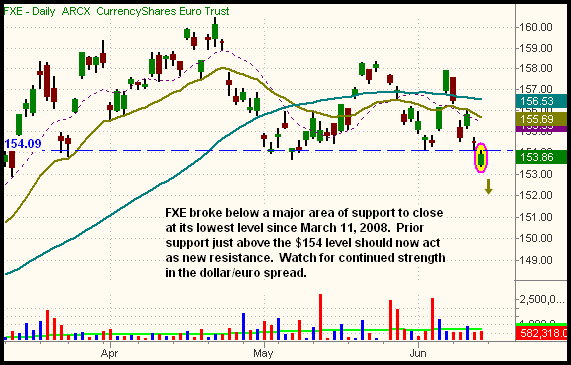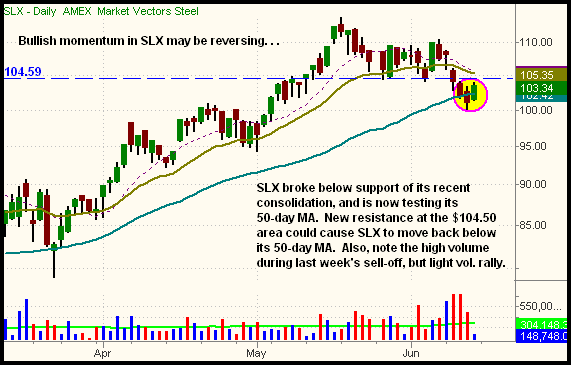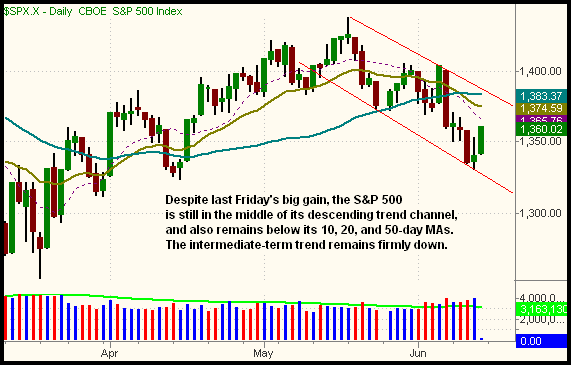|
The Wagner Daily ETF Report For June 16
Stocks concluded last week on a positive note, enabling the major indices to recover more than a third of June's substantial losses. As it did in three of the four preceding days, the broad market rallied in the morning, then began to drop in the early afternoon. But this time, the bulls drove stocks higher in the final ninety minutes, breaking the pattern of late-day sell-offs that has been plaguing the market. The Nasdaq Composite gained 2.1%, the S&P 500 1.5%, and the Dow Jones Industrial Average 1.4%. The small-cap Russell 2000 and S&P Midcap 400 indices climbed 1.9% and 1.6% respectively. Each of the main stock market indexes closed at its intraday high for a change.
The only problem with last Friday's rally is that the gains occurred on lighter volume. Total volume in both the NYSE and Nasdaq declined 7% below the previous day's levels. Higher volume would have indicated an appetite for stocks among mutual funds, hedge funds, and other institutions, a necessary requirement in order for gains to be sustained. When the market rallies on declining volume, it only takes one wave of institutional selling to undo many days of gains. Thanks to strength in the final thirty minutes of trading, market internals were decent. Advancing volume exceeded declining volume by a ratio of more than 7 to 2 in both exchanges.
Recent strength in the U.S. dollar caused the CurrencyShares Euro Trust (FXE), which follows the price of the euro/U.S. dollar spread, to break down to close at its lowest level since March 11 of this year. This is shown on the daily chart of FXE below:

After initially breaking down below its 50-day MA on May 1, FXE quickly found support and moved back above it later in the month. However, FXE ran out of gas and fell back below its 50-day MA a few days later. On June 6, FXE valiantly took another shot at reclaiming its 50-day MA, but only managed to close above that pivotal resistance level for one day before heading south again. As the horizontal line on the chart above illustrates, FXE is now breaking down below a major area of price support. Clearly, momentum has reversed in the euro/dollar.
The obvious way to take advantage of newfound strength in the U.S. dollar is to sell short FXE, but that ETF may be hard to borrow at some brokers. An alternative is to buy UUP (PowerShares U.S. Dollar Bullish Index), which generally moves higher alongside of the dollar. However, realize that UUP tracks the price of the U.S. dollar against an index of various international currencies. FXE, on the other hand, is strictly pegged to the euro/dollar. As such, there is not necessarily a direct inverse correlation between the price of FXE and UUP. Further, realize that UUP has a very low day-to-day volatility. Therefore, a large number of shares is required in order to profit from a rally in UUP.
Another ETF that may be finally reversing its bullish momentum is the Market Vectors Steel (SLX). Its daily chart is shown below:

After trading at its all-time high in mid-May, SLX retraced modestly and began consolidating in a sideways range for two weeks, right at support of its 20-day EMA. Such action should have eventually led to another breakout to new highs, but SLX fell below the low of its consolidation instead. On June 12, SLX closed below its 50-day moving average for the first time in more than four months. The following day's broad market rally pushed SLX back above its 50-day MA, but now it's faced with new resistance of its prior consolidation (the dashed horizontal line). Resistance of the 20-day EMA is also overhead.
More importantly than recent price action is last week's volume patterns in SLX. On the chart above, notice the high volume that occurred from June 10 - 12, as SLX was selling off. The high volume selling was subsequently followed by light, below average volume when SLX moved back above its 50-day MA on June 13. This tells us that SLX was under distribution last week, which is likely to remain the case this week. As such, there's a good chance SLX will fall back below its 50-day MA within the next several days. Downside momentum could subsequently push SLX sharply lower in the short-term. We plan to initiate a short sale in SLX if/when it breaks below last Friday's intraday low of $101.56. Regular subscribers to The Wagner Daily should note our specific trigger, stop, and target prices below.
Despite the sizable percentage gains of last Friday's broad-based rally, there were no changes to the intermediate-term trends of the major indices. The S&P 500, for example, has formed two significant "lower lows" and "lower highs" since forming its peak in the middle of last month. Even with last Friday's 1.5% gain, the index is still well below the upper boundary resistance of its intermediate-term downtrending channel. The descending trend channel of the S&P 500 is shown on the daily chart below:

In addition to the S&P remaining below the upper boundary of its intermediate-term downtrending channel, the index is also firmly below its 20 and 50-day moving averages. It's still even five points below its 10-day moving average (the purple dashed line), an indicator of very short-term momentum. It's therefore apparent that last Friday's rally was no more than a near-term bounce from "oversold" conditions. If the benchmark S&P 500 moves back above its 20 and 50-day moving averages, it would also break out above the upper boundary of its downtrend. At that point, it would be much lower risk to be on the long side of the market. But until that happens, we have no choice but to view the current bounce as a chance to enter new short positions in weak ETFs, not the opportunity to begin aggressive buying. Trading what you see, not what you think consistently keeps your trading account out of harm's way.
Open ETF positions:
Long - RSX, DUG
Short - (none)
Deron Wagner is the Founder and Head Trader of both Morpheus Capital LP, a U.S. hedge fund, and Morpheus Trading Group, a trader education firm launched in 2001 that provides daily technical analysis of the leading ETFs and stocks. For a free trial to the full version of The Wagner Daily or to learn about Wagner's other services, visit MorpheusTrading.com or send an e-mail to deron@morpheustrading.com.
|